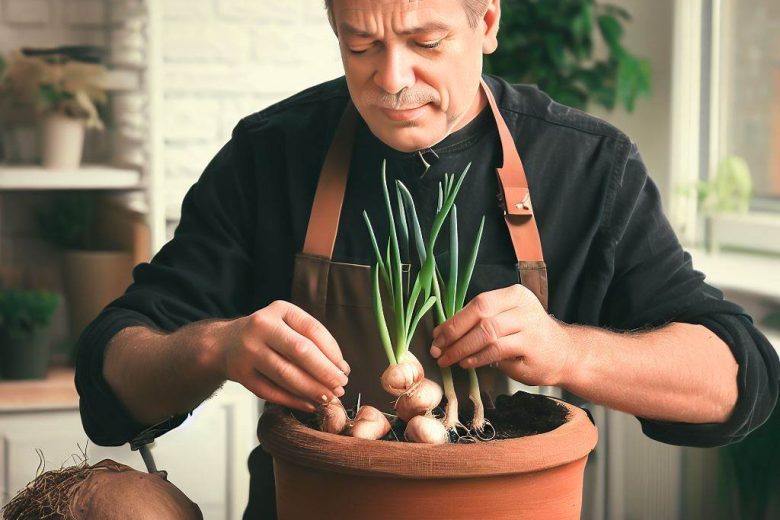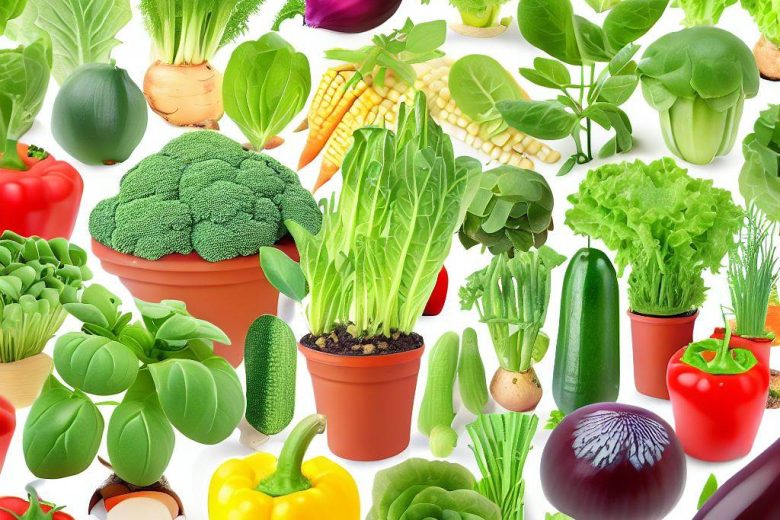Gardening enthusiasts and those with limited outdoor space often find joy in growing vegetables indoors. This practice not only provides a fresh supply of organic produce but also adds a touch of nature to your living space. Some of the easy-to-grow vegetables indoors are Spinach, Lettuce, Kale, Basil, Mint, and Parsley.
In this article, we’ll explore the 25 easiest vegetables to grow indoors, and provide you with a step-by-step guide to get started on your indoor gardening journey.
25 Easiest Vegetables To Grow Indoors

1. Spinach
Spinach is a nutritious leafy green that thrives indoors. Choose a variety like baby spinach for its compact size. Plant seeds in well-draining soil and ensure they receive sufficient light. Harvest the outer leaves as they grow.
Read Also: 25 Fastest Growing Vegetables in Summer
2. Lettuce
Lettuce varieties such as loose-leaf and butterhead are ideal for indoor gardens. Use shallow containers and provide consistent moisture. Harvest leaves from the outer layer, allowing the inner ones to continue growing.
3. Kale
Kale is rich in nutrients and easy to cultivate indoors. It appreciates cooler temperatures and requires adequate light. Regularly harvest mature leaves to encourage new growth.
Read Also: [Complete Guide] 50 Gardening Tips For Beginners
4. Basil
Basil is a fragrant herb that’s perfect for indoor gardening. Place it in a sunny spot and keep the soil consistently moist. Regular pruning promotes bushier growth.
5. Mint
Mint is known for its refreshing aroma and culinary uses. It thrives in containers and prefers partial sunlight. Be mindful of its invasive nature and consider planting it in a separate pot.
Read Also: How Fast Do Cucumbers Grow? 10 Tips to Accelerate Growth
6. Parsley
Parsley adds flavor and color to dishes. It requires bright, indirect light and well-draining soil. Regularly pinch off stems to encourage fuller growth.
7. Cherry Tomatoes
Compact cherry tomato varieties like Tiny Tim are suitable for indoor gardens. Provide ample light and support for the vines as they grow. Water consistently and watch for pests.
Read Also: How Long Does a Peach Tree Take to Grow: 10 Tips to Grow Faster
8. Radishes
Radishes are fast-growing root vegetables. Plant them in deep containers with well-draining soil. They prefer cooler temperatures and mature quickly, allowing for frequent harvests.
9. Carrots
Carrots can be grown indoors if you choose shorter varieties. Use deep containers filled with loose soil to accommodate their root development. Keep the soil consistently moist.
Read Also: How Long Does It Take for Raspberries to Grow? [10 Tips To Grow Faster]
10. Green Onions
Green onions are versatile and easy to grow indoors. Plant onion sets in a container with well-draining soil. Harvest the tops as needed, allowing the bulbs to continue growing.
11. Microgreens
Microgreens, such as arugula and radish greens, are nutrient-dense and grow quickly. Scatter seeds densely in shallow containers. Harvest when the first true leaves appear.
12. Peppers
Smaller pepper varieties like chili peppers can be grown indoors. Provide ample sunlight and warmth. Pollination might require manual assistance by gently shaking the plants.
Read Also: [Beginner’s Guide] Planning Your Vegetable Garden Layout
13. Cucumbers
Dwarf cucumber varieties can thrive indoors. Provide a trellis for support and ensure they receive adequate light and warmth. Regularly pollinate flowers using a soft brush.
14. Zucchini
Dwarf zucchini plants can be grown indoors with proper care. Provide a large container and support for the vines. Hand-pollinate the flowers to ensure fruit set.
15. Beans
Bush bean varieties are suitable for indoor cultivation. Use deep containers and provide support for the plants. Beans require good light and regular watering.
Read Also: [Beginner’s Guide] How To Grow Watermelon In Africa
16. Squash
Compact squash varieties, like pattypan squash, can be grown indoors. Provide a spacious container and proper support for the vines. Hand-pollination may be necessary.
17. Tomatillos
Tomatillos can be grown indoors for their tangy fruits. They require ample sunlight and well-draining soil. Prune the plants to encourage air circulation.
18. Swiss Chard
Swiss chard’s colorful stems and nutritious leaves make it a great indoor choice. Plant in well-draining soil and provide bright, indirect light. Harvest outer leaves to encourage growth.
Read Also: Top 10 Avocado Farming Counties in Kenya
19. Beets
Beets can be grown indoors for their flavorful roots and greens. Use deep containers and well-draining soil. Thin seedlings as they grow to allow proper development.
20. Cilantro
Cilantro is a versatile herb with culinary uses. It prefers cooler temperatures and indirect light. Sow seeds regularly for a continuous supply.
21. Thyme
Thyme is a hardy herb that can be grown indoors. It requires well-draining soil and bright light. Prune regularly to maintain its shape and encourage growth.
22. Rosemary
Rosemary is a fragrant herb that thrives indoors with adequate sunlight. Use a well-draining mix and allow the soil to dry slightly between waterings. Prune to maintain shape.
23. Oregano
Oregano is a flavorful herb that’s easy to grow indoors. It prefers bright light and well-draining soil. Regular pruning encourages bushier growth.
24. Lemon Balm
Lemon balm is a fragrant herb with calming properties. It grows well in containers and prefers partial sunlight. Keep the soil consistently moist.
25. Lavender
Lavender can be grown indoors for its aromatic blooms. Use well-draining soil and provide ample sunlight. Prune faded flowers to promote new growth.
By selecting a variety of these 25 easiest vegetables to grow indoors, you can create a thriving indoor garden that provides fresh produce and enhances your living space. Remember to consider each vegetable’s specific needs and follow the step-by-step guide outlined earlier in the article to ensure a successful indoor gardening experience.
Setting Up Your Indoor Garden
Container Selection
Choose containers with proper drainage to prevent waterlogging. Size matters; ensure containers are appropriate for the chosen vegetables’ growth.
Lighting
Since natural light indoors might be limited, supplement with grow lights. LED grow lights are energy-efficient and provide the necessary spectrum for plant growth.
Soil and Fertilization
Opt for well-draining potting mix enriched with nutrients. Consider organic fertilizers to ensure your plants receive essential nourishment.
Watering
Proper watering is crucial. Avoid overwatering, which can lead to root rot. Stick your finger into the soil; water when the top inch feels dry.
Temperature and Humidity
Maintain appropriate temperature and humidity levels for each vegetable. Most indoor vegetables prefer temperatures between 60-75°F (15-24°C).
Pruning and Harvesting
Regularly prune to encourage bushier growth. Harvest vegetables as they mature to promote continuous production.
Common Challenges and Solutions
Indoor gardening can pose challenges such as pest infestations and diseases. Use natural remedies like neem oil or introduce beneficial insects to control pests.
Can You Grow Vegetables Indoors All Year Round?
Yes, you can grow vegetables indoors throughout the year with proper planning and care. Indoor gardening allows you to control environmental conditions such as temperature, light, and humidity, making it possible to create a year-round growing environment. However, it’s essential to choose vegetables that are well-suited for indoor cultivation and to provide the necessary conditions for their growth.
What Vegetable Grows Fast Indoors?
Microgreens are among the fastest-growing vegetables you can cultivate indoors. These tiny greens are packed with nutrients and add a burst of flavor to dishes. Microgreens typically germinate and reach harvestable size within 1-3 weeks, depending on the variety. Some common microgreens include arugula, radish greens, and sunflower shoots.
What Vegetables Are Best Started Indoors?
Several vegetables benefit from being started indoors before being transplanted outdoors. This practice, known as “starting seeds indoors,” allows plants to establish strong roots and gain a head start on the growing season. Some examples of vegetables that are best started indoors include tomatoes, peppers, eggplants, broccoli, and cauliflower.
What Vegetables Grow Indoors in Winter?
During the winter months, when outdoor gardening might be challenging due to cold temperatures, several vegetables thrive indoors. Leafy greens like spinach, kale, and lettuce, as well as herbs like parsley and mint, can be grown successfully indoors during the winter. Providing adequate lighting and maintaining appropriate temperatures are key to their growth.
Growing Vegetables Indoors for Beginners
For beginners, starting with easy-to-grow vegetables is a great approach. Leafy greens such as lettuce and spinach, along with herbs like basil and parsley, are excellent choices. These plants have relatively simple care requirements and can adapt well to indoor environments. As you gain experience, you can experiment with more challenging vegetables.
Best Vegetables to Grow Indoors Under Lights
When growing vegetables indoors, proper lighting is crucial. Using grow lights ensures that your plants receive the right spectrum of light for optimal growth. Leafy greens, herbs, microgreens, and compact tomato varieties are some of the best vegetables to grow under lights. Make sure to position the lights at the right distance to prevent leggy growth.
Fastest Growing Vegetables Indoors
If you’re looking for rapid results, consider growing radishes indoors. Radishes are known for their quick growth, and they can be ready for harvest in as little as 3-4 weeks. Other fast-growing options include baby spinach, arugula, and certain lettuce varieties.
Vegetables That Can Grow Indoors Without Sunlight
While most vegetables require some form of light to grow indoors, there are a few that can tolerate lower light conditions. Some options include mushrooms, which don’t need light for photosynthesis, and certain herbs like mint and chives, which can thrive in indirect light. Keep in mind that even these plants will benefit from some exposure to natural or artificial light.
Can I grow root vegetables indoors?
Yes, root vegetables like carrots and radishes can be grown indoors, provided you use deep containers and well-draining soil.
How often should I fertilize my indoor vegetables?
Fertilize every 4-6 weeks using a diluted, balanced liquid fertilizer.
Can I use regular household lights for indoor gardening?
While regular lights emit some light, they might not provide the optimal spectrum for plant growth. Consider investing in grow lights.
What is the best location for my indoor garden?
Choose a spot near a window with sufficient sunlight, or supplement with artificial lighting.
How do I prevent mold in my indoor garden?
Ensure proper air circulation and avoid over-watering to prevent mold growth.
Conclusion
Indoor vegetable gardening offers a world of possibilities, allowing you to enjoy fresh produce and experiment with different plants regardless of the season. Whether you’re a beginner or an experienced gardener, understanding the specific needs of each vegetable and providing the right conditions will contribute to your success in growing vegetables indoors



